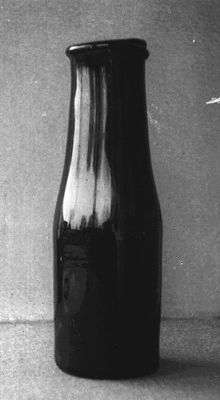Nicolas Appert
| Nicolas Appert | |
|---|---|
 Nicolas Appert 1841 | |
| Born |
17 November 1749 Châlons-sur-Marne, France |
| Died |
1 June 1841 (aged 91) Massy, France |
| Nationality | French |
| Signature | |
 | |
Nicolas Appert (17 November 1749 Châlons-sur-Marne (present Châlons-en-Champagne), present Marne – 1 June 1841 Massy), was the French inventor of airtight food preservation. Appert, known as the "father of canning", was a confectioner.[1]
Biography
Appert was a confectioner and chef in Paris from 1784 to 1795. In 1795, he began experimenting with ways to preserve foodstuffs, succeeding with soups, vegetables, juices, dairy products, jellies, jams, and syrups. He placed the food in glass jars, sealed them with cork and sealing wax and placed them in boiling water.[2]
In 1795 the French military offered a cash prize of 12,000 francs for a new method to preserve food. After some 14 or 15 years of experiment, Appert submitted his invention and won the prize in January 1810 on condition that he make the method public; the same year, Appert published L'Art de conserver les substances animales et végétales (or The Art of Preserving Animal and Vegetable Substances). This was the first cookbook of its kind on modern food preservation methods.[3][4][5]

La Maison Appert (English: The House of Appert), in the town of Massy, near Paris, became the first food bottling factory in the world,[2] years before Louis Pasteur proved that heat killed bacteria. Appert patented his invention and established a business to preserve a variety of food in sealed bottles. Appert's method was to fill thick, large-mouthed glass bottles with produce of every description, ranging from beef, fowl, eggs, milk, and prepared dishes (according to sources). His greatest success for publicity was an entire sheep. He left air space at the top of the bottle, and the cork would then be sealed firmly in the jar by using a vise. The bottle was then wrapped in canvas to protect it, while it was dunked into boiling water and then boiled for as much time as Appert deemed appropriate for cooking the contents thoroughly.
In honor of Appert, canning is sometimes called "appertisation", but should be distinguished from pasteurization. Appert's early attempts at food preservation by boiling involved cooking the food to a temperature far in excess of what is used in pasteurization (70 °C (158 °F)), and can destroy some of the flavour of the preserved food.
Appert's method was so simple and workable that it quickly became widespread. In 1810, British inventor and merchant Peter Durand also of French origin, patented his own method, but this time in a tin can, so creating the modern-day process of canning foods. In 1812 Englishmen Bryan Donkin and John Hall purchased both patents and began producing preserves. Just a decade later, the Appert method of canning had made its way to America. Tin can mass production was however not common until the beginning of the 20th century, partly because a hammer and chisel were needed to open cans until the invention of a can opener by an Englishman named Yates in 1855.[2]
Posthumous honors
In 1991, a monumental statue of Appert, a work in bronze by the artist Jean-Robert Ipousteguy, was erected in Châlons-en-Champagne. A plaque was affixed to his birthplace in 1986.
In 1999, busts of Appert by Richard Bruyère were erected in Institute of Food Technologists I.F.T. Chicago (USA), Massy, and Museum of Fine Arts in Châlons-en-Champagne.
In 2010, a statue of Appert by Roger Marion was erected in Malataverne (France).
A room in the Museum of Fine Arts and Archeology of Châlons-en-Champagne was dedicated to him, (collection Jean Paul Barbier and AINA detail objects on the site of the international association Nicolas Appert.[6]
There are 72 streets named after Nicolas Appert in France, and one in Canada.
There is a high school named after Nicolas Appert in Orvault, France.
In 1955 a French postal stamp commemorated him.
2010 was declared Nicolas Appert Year, a national celebration, by the French ministry of culture. The Principality of Monaco issued a postage stamp featuring Appert. An exhibition entitled "Mise en boîte" was held at the Musée des Beaux-Arts et d'Archéologie de Châlons-en-Champagne.
Nicolas Appert Award
Since 1942, each year the Chicago Section of the Institute of Food Technologists awards the Nicholas Appert Award, recognizing lifetime achievement in food technology.
Study Association
The student association of the Food Technology education at Wageningen University is called Nicolas Appert. Since 1972 this association has focused on improving the courses related to food technology education and organises several events each year for students and alumni. Currently almost 300 bachelor and master students are members. In 2007 the association celebrated its 9th lustrum.[7]
Sources
- "Nicolas Appert inventeur et humaniste" by Jean-Paul Barbier, édition Royer, Paris, 1994 (ISBN 2-908670-17-8)
- "Encyclopedia of World Biography Supplement", Vol. 20. Gale Group, 2000.
See also
References
- ↑ Jean-Paul Barbier Nicolas Appert inventeur et humaniste, Royer, 1994, Paris.
- 1 2 3 Lance Day, Ian McNeil, ed. (1996). Biographical Dictionary of the History of Technology. Routledge. ISBN 0-415-19399-0.
- ↑ Gordon L. Robertson, Food Packaging: Principles and Practice, Marcel Dekker, 1998, p. 187
- ↑ The First Book on Modern Food Preservation Methods (1810)
- ↑ Nicolas Appert in 1810 was probably the first person ...
- ↑ Appert-aina.com
- ↑ Nicolasappert.nl (Dutch) (English) and some parts in Chinese
External links
| Wikimedia Commons has media related to Nicolas Appert. |
|